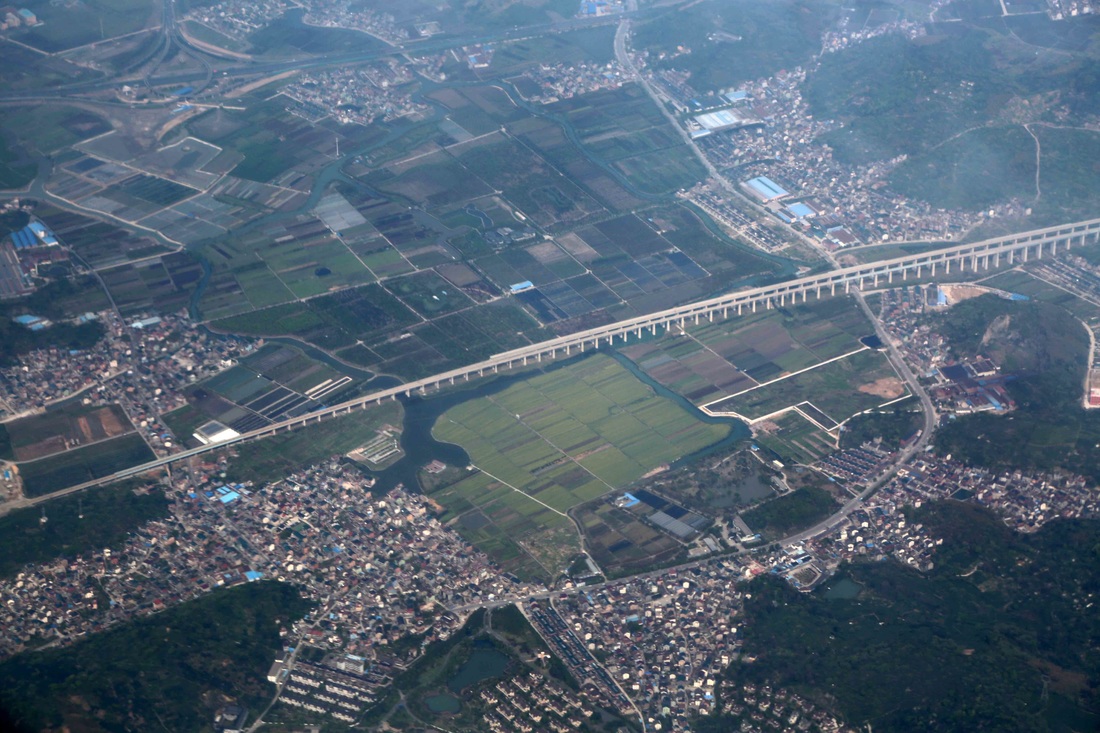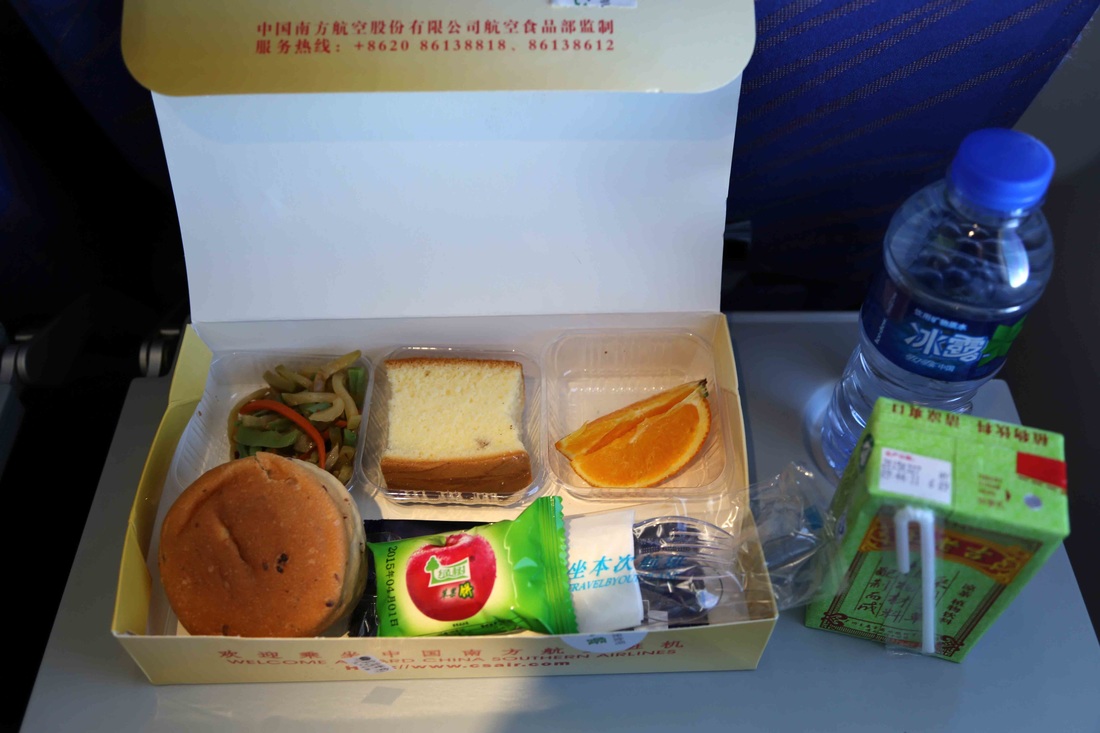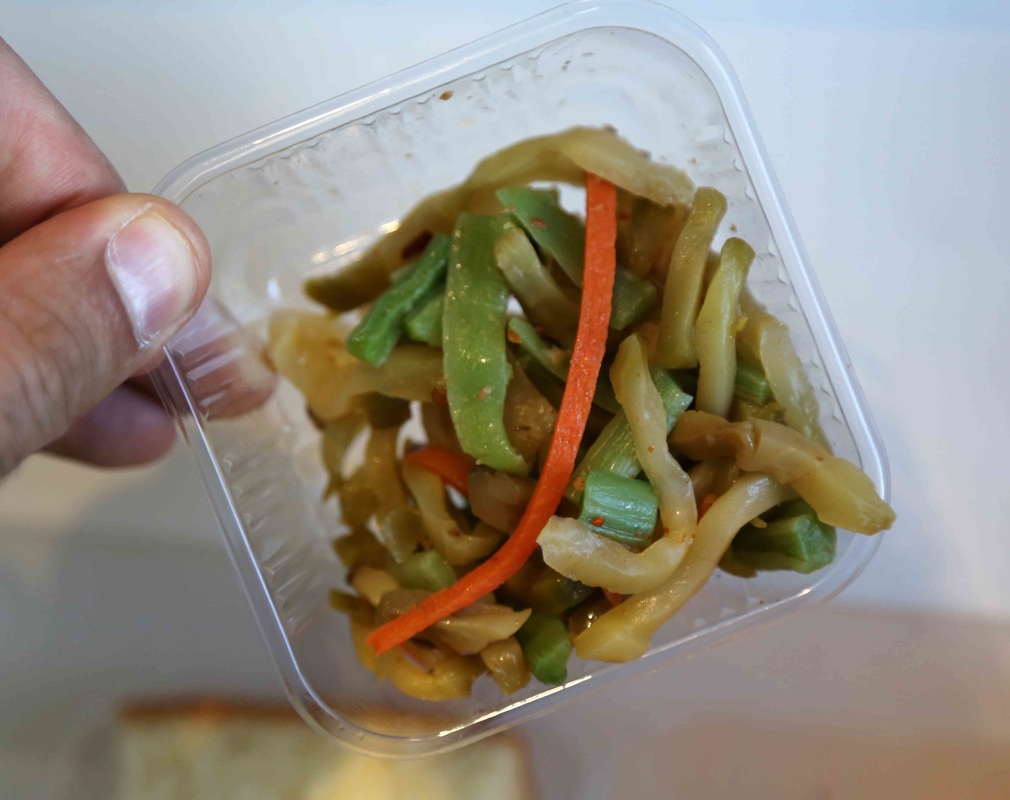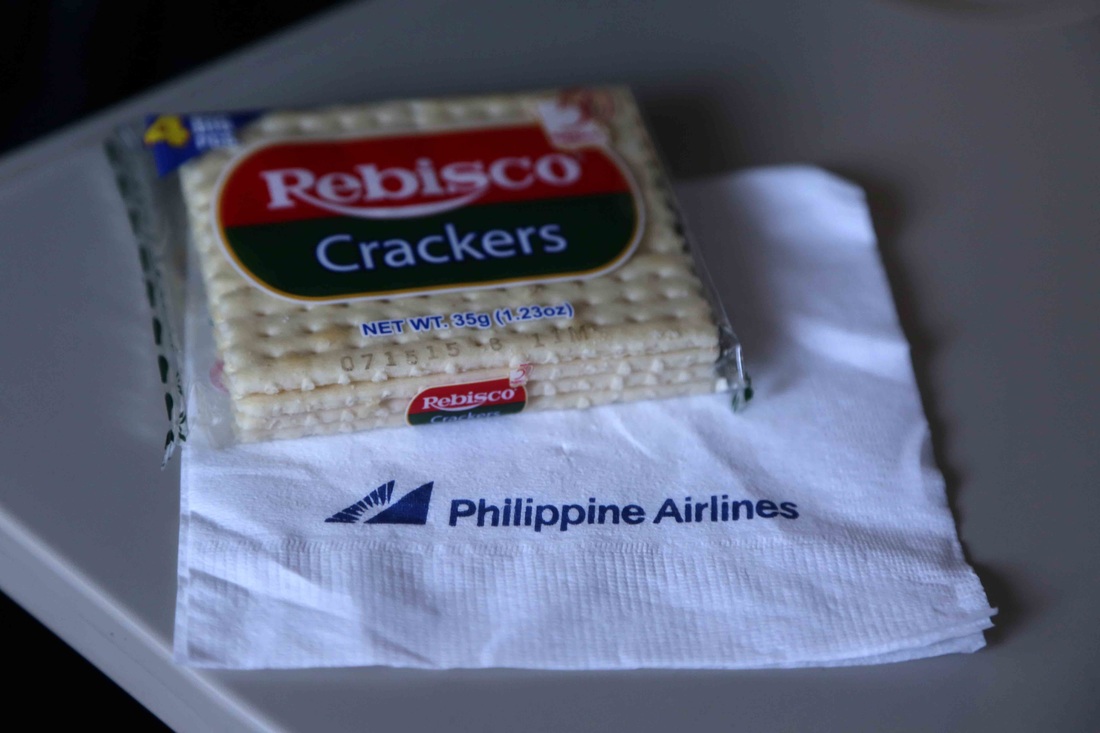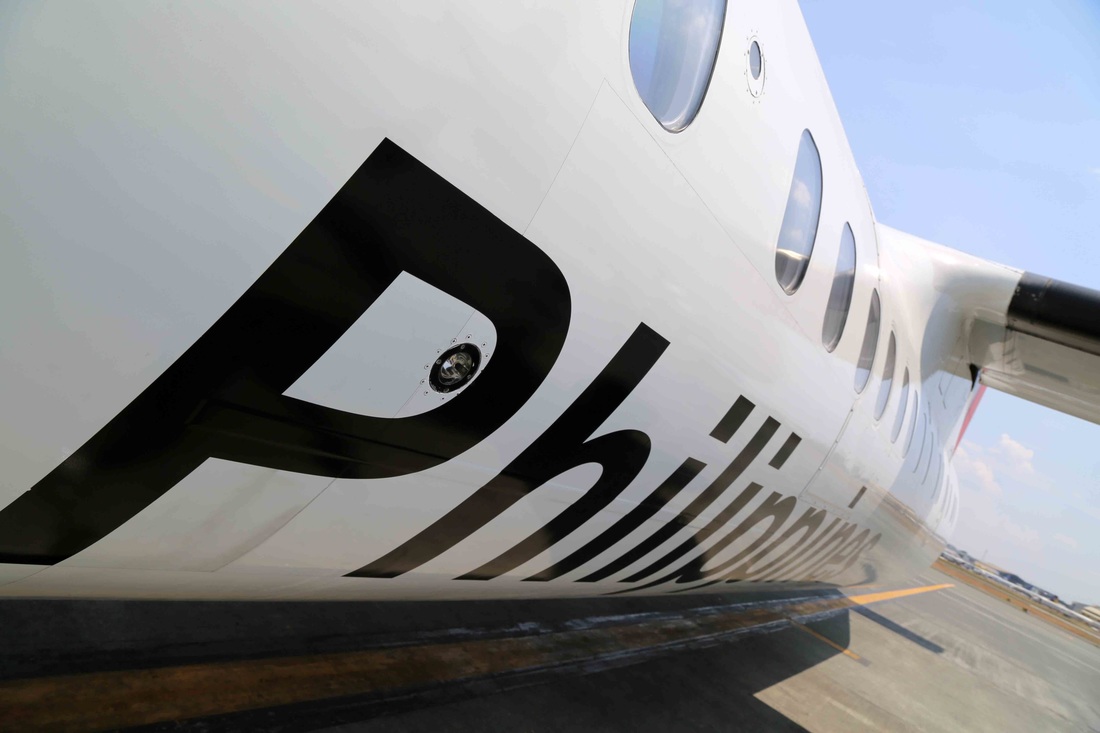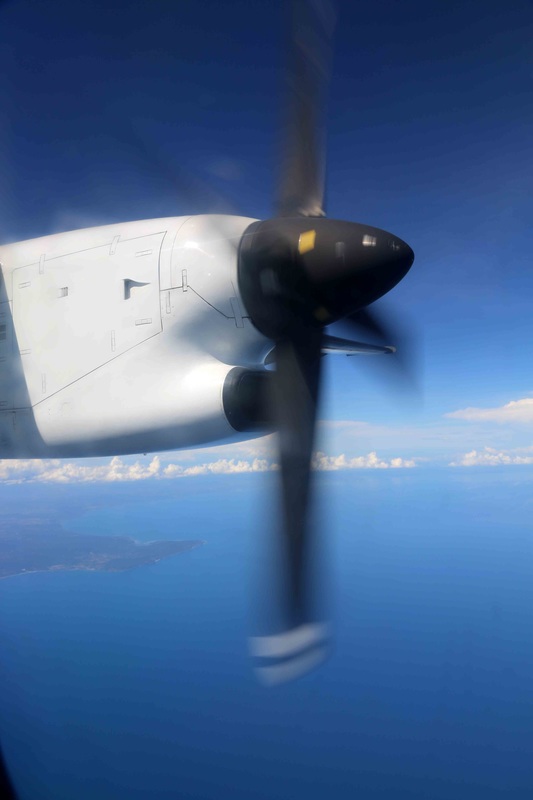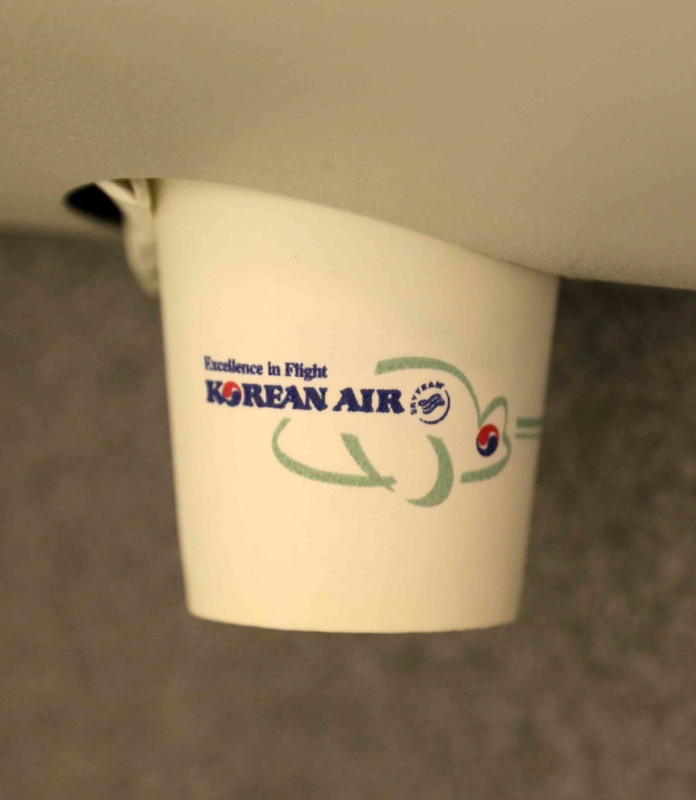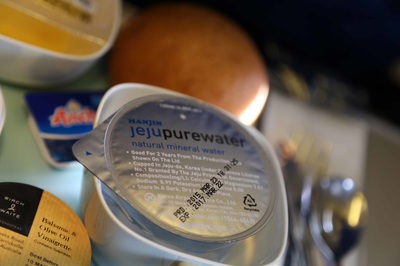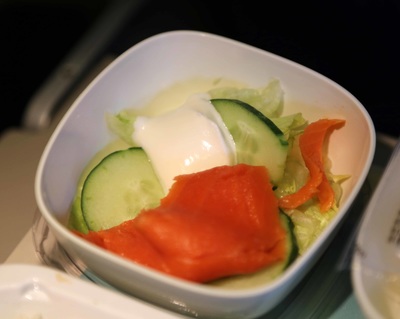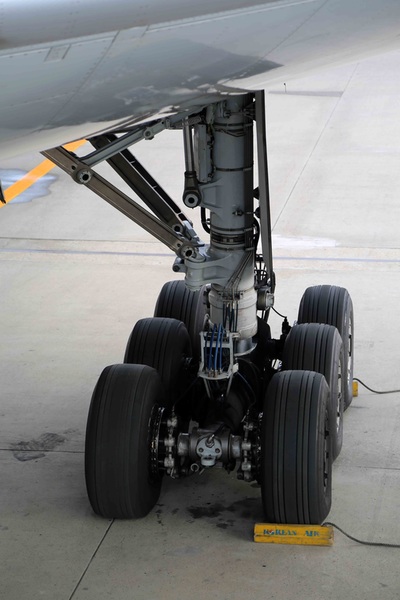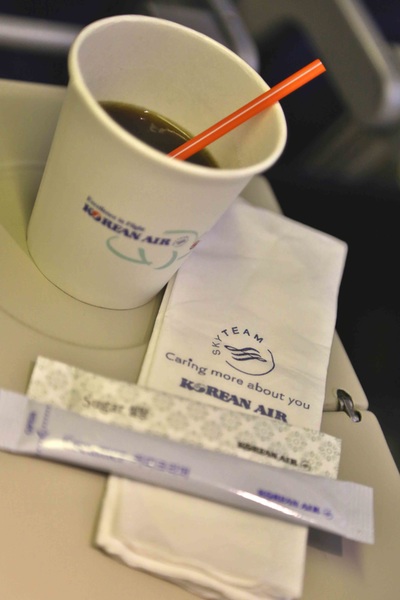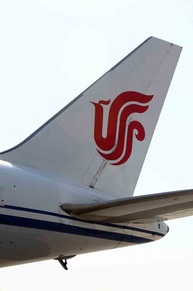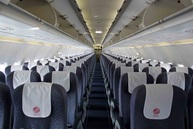|
Route: Hangzhou International Airport to Guangzhou Baiyun International
Departure date and time of flight: 08:20am on 26 April, 2015 Flight number: CZ3820 Flight duration: 2 hours 10 minutes Class: Economy Class Aircraft type: Boeing 737-700 Punctuality of the flight: The flight departed on time and landed on time. Any baggage issues: No issues- the bags arrived on time and in one piece. Comments regarding the pre-meal service: Just drinks (non-alcoholic), and including tea and coffee. Comments regarding the first meal: A box containing a simple bun, bread roll with pickles, an orange slice and a packet of apple crisps Comments regarding the drinks service: A second round of drinks were offered after the meal. No Alcohol, but plenty of milk, coffee and tea. Comments regarding the in-flight snacks (if any): None Comments regarding the second meal (if any): None Comments on the in-flight system (if any): None Comments on the interior of the aircraft (including seat comfort): The 737-700 plane has a seat configuration of 3-3 with an all Economy Class seat set up. The plane was clean and the toilets were clean too. It was not full at all. Not bad a flight after all. The crew were friendly too. PAL EXPRESS (Caticlan International Airport- Manila International Airport), Bombardier 300 (Dash-8)4/20/2015
PAL Express, formerly Air Philippines or Airphil Express, is an airline operating under the business name of Air Philippines Corporation. It operates domestic and international scheduled services from Manila, Cebu, Davao City and Zamboanga. The airline has been re-branded a number of times, first as Air Philippines, then Airphil Express, and is now known as PAL Express. After a series of financial losses, Air Philippines ceased operations until it was acquired by investors from Philippine Airlines. After the acquisition, the airline was re-launched as PAL Express, operating some routes and slot assignments of its sister company Philippine Airlines until management decided to re-brand the carrier as a budget airline known as Airphil Express. However, in March 2013, the company's CEO announced that the name would revert to PAL Express. As a codeshare partner of Philippine Airlines, PAL Express operates as a full service carrier within a low-cost model.
PAL Express is Philippine Airlines' answer to Cebu Pacific Air's dominance in the low-cost travel market in the Philippines. It has allowed PAL to focus on the premium market, where domestically PAL does not have competition. Airphil Express gained a significant increase in passengers following its launch as a low-cost carrier. The airline is currently in fleet acquisition model to support its planned domestic and international route expansion plan. Airphil Express currently holds the no. 3 position among Philippine-based airlines, with 19% market share. The Dash-8 aircraft is used for domestic routes, especially to the smaller island airports. I took this flight from Boracay’s Caticlan Airport to Manila. Route: CATICLAN AIRPORT- MANILA AQUINO INTL. AIRPORT Departure date and time of flight: April 2015, 09:30 Flight number: PR2040 (ICAO callsign: “AirPhil 2040”) Flight duration: 40 minutes Cabin: FIESTA ECONOMY CLASS Aircraft type: Dash 8-300 (9 in service) Aircraft registration: RP-C3017 Engine Type: Two x PWC PW123 Aircraft Serial Number: 657 Frequent flyer programme: Mabuhay Miles Seat configuration for this aircraft: Economy Class: 76 seats in a 2-2 configuration Any baggage issues: No issues regarding the baggage. For First and Business Class, Philippine Airlines have a checked baggage allowance of 40 kg and 30 kg total respectively for all routes excluding transatlantic routes. Economy Class passengers can take 23kg in the hold. All routes have a carry-on allowance of one piece not exceeding 7 kg (50x37x25 cm). Comments on the check-in: I arrived around an hour early for check-in at the quiet and tiny. It is a tiny building, with the departures and arrivals all in one room. On one side are the taxis waiting to take passengers to the Island, and on the other side are planes. The runway and the terminal are surrounded by lush green. Punctuality of the flight: Departed bang on time and we landed in Manila around five minutes early due to low air traffic in the area. The taxi from the runway to the airport terminal building is quite a long one. Comments regarding the meal: Just a packet of crackers, and a bottle of water. Comments on the in-flight entertainment system: None Comments of professionalism of the cabin crew: The cabin crew were very hospitable, and proud to work for Philippine Airlines. There was a genuine smile on every crewmembers face and you could tell that they really enjoyed their job. There was a real sense of teamwork in the cabin. As a customer (or passenger) it is easy to tell if the cabin crew are not getting along with each other (it does happen like any other job!), and on this flight I could see that everyone was in a joyous mood. If there was something I wanted or a question I had, then no one objected to it. Instead, they tried their best to help me as much as they could. The senior purser was just gem of a person. The whole flight experience was like magic, and everything seemed to go smoothly. Therefore, yes the world can be ideal sometimes. For such a short flight and a tiny aircraft, there are only two cabin crew members, one located at each end of the aircraft. Comments on the interior of the aircraft (including seat comfort): There are 76 seats in the Bombardier Dash-8 300, with a 2-2 configuration. The flight had an interesting mix of stereotypical passengers that you would expect coming back from an exotic island, such as Boracay. The flight consisted of a gay couple (one of the men had a rooster style haircut…pink hair, naturally), there was a very old white foreigner with his very young Filipino mail order bride, and there were American college students, who were clearly looked as though they were in Boracay to just mess around. All in all, it just seemed very comical…something like out of a movie…except that we were not expecting any ditching onto a remote island. Philippine Airlines logo and livery: The Philippine Airlines logo has gone under four incarnations in the entire length of its operations. The first logo incorporated a blue oval with "PAL" superimposed in white letters, a four-pointed star whose points intersect behind the "A" in the PAL initials, and a wing whose position varied depending on the location of the logo (the wing points to the right if located on the left side of the plane, left if on the right side). A variant of this logo used a globe instead in the blue oval with the PAL initials superimposed. This logo would be in use from the 1950s until the mid-1960s, when it would be replaced by a second logo. The second logo adopted a blue triangle (with the bottom point missing) and a red triangle superimposed upon it, enclosed by a circle; this was meant to evoke a vertically-displayed national flag (the white being formed by the negative space between the two triangles' tips). In the mid-1970s, a third logo, which removed the circle and simplified the shapes, was introduced. The typeface used in the third logo was later applied to the second logo, which remained the official PAL logo until 1986, when it would be replaced by the current logo. The current PAL logo features the same two blue and red triangles used in the second and third logos. However, an eight-rayed yellow sunburst that recalled the flag's Sun was superimposed on top of the blue triangle, and a new Helvetica typeface was used. PAL liveries have undergone many incarnations. The first PAL aircraft bore a simple white-top, silver-bottom livery separated by solid straight cheatlines, with a small Philippine flag superimposed on the tail. The name "Philippine Air Lines" was superimposed in the upper forward portion of the fuselage and the PAL logo was located at the back. Later variants of the livery, especially on PAL jet aircraft, made use of an extended Philippine flag as cheatlines, with the PAL logo superimposed on the tail. By this time, the name "Philippine Airlines" was used in the livery. Another variant of the original livery used by PAL is somewhat similar to the current livery. However, it uses PAL's third logo on the tail with blue, white and red cheatlines running the center of the fuselage. Later on, the bottom half of the fuselage was also painted white. The current "Eurowhite" livery, first used with the Short 360, was adopted in 1986 following PAL's corporate rebranding. This livery, (designed by Landor Associates) has the name "Philippines" superimposed on the forward portion of the fuselage in italics (using the PAL logo typeface), while the tail is painted with the logo and the Philippine flag is visible near the rear of the aircraft. The PAL logo is also painted on the winglets of aircraft that have them. The name "Philippines", instead of "Philippine Airlines", is to denote that PAL is the primary flag carrier of the Philippines. However, this sometimes leads to confusion that a PAL plane, especially when chartered by the President for official or state visits, is in fact the official air transport of the Philippine head of state. Any PAL aircraft with the callsign PR 001 is a special plane operated by Philippine Airlines to transport the President of the Philippines. For the airline's 70th anniversary, a special decal was placed on all of its aircraft. The sticker featured a stylized "70" and the words, "Asia's first, shining through". Overall rating 1-10 (worst-best): 10 Philippine Airlines (PAL) is the national flag carrier of the Philippines. The airline was founded in 1941 and is the first and oldest commercial airline in Asia operating under its original name. Operating out of its hubs at Ninoy Aquino International Airport of Manila and Mactan-Cebu International Airport of Cebu, Philippine Airlines uses a fleet of 56 aircraft (with 37 on order), and serves 31 destinations in the Philippines and 36 overseas destinations in Southeast Asia, East Asia, Middle East, Oceania, North America and Europe.
Formerly one of the largest Asian airlines, PAL was severely affected by the 1997 Asian Financial Crisis. In one of the Philippines' biggest corporate failures, PAL was forced to downsize its international operations by completely cutting flights to Europe and Middle East, cutting virtually all domestic flights except routes operated from Manila, reducing the size of its fleet, and laying off thousands of employees. The airline was placed under receivership in 1998, and gradually restored operations to many destinations. PAL exited receivership in 2007, and following the brief management takeover by the San Miguel group from 2012 to 2014, has been taking steps towards re-establishing itself as one of Asia's premier carriers. The Airbus A330 aircraft is used for regional routes around the Asia Pacific region and China. I took this flight from Manila to Hong Kong, having travelled to Manila from Caticlan Airport in Boracay. Route: MANILA AQUINO INTL. AIRPORT (MNL) to HONG KONG INTERNATIONAL AIRPORT (HKG) Departure date and time of flight: April 2015, 15:30 Flight number: PR311 (ICAO callsign: “Philippine 311”) Flight duration: Two hours and ten minutes Cabin: FIESTA ECONOMY CLASS Aircraft type: AIRBUS A330-343 (15 in service) Unit cost of each Airbus A330: US$253.7M, €231.3M (2015) Aircraft registration: RP-C8766 (First flight October 1, 2014) Engine Type: Two x Rolls Royce Trent 772B-60 Aircraft Serial Number: 1566 Frequent flyer programme: Mabuhay Miles Seat configuration for this aircraft: First Class: 18 seats in a 2-2-2 configuration Premium Economy Class: 27 seats in a 3-3-3 configuration Economy Class: 323 seats in a 3-3-3 configuration Philippine Airlines currently offers two-class services on all aircraft, business (called Mabuhay Class) and economy (called Fiesta Class). During the second half of 2006, PAL announced a cabin reconfiguration project for its Boeing 747-400 and Airbus A340-300 aircraft. The airline spent US$85.7 million to remove all first class seats and increase the size of its business and economy seats, leading to the aforementioned new seats; as well as add personal screens with audio and video on-demand (AVOD) across both cabin classes. The cabin reconfiguration project began in the third quarter of 2008. The first 747-400 to be reconfigured (reg. RP-C7471) re-entered service in October 2008. The second reconfigured plane (reg. RP-C7475) was completed in May 2009, and the third (reg. RP-C7472) was completed July 2009. The fourth 747 (reg. RP-C7473) began reconfigured work in August 2009. Any baggage issues: No issues regarding the baggage. For First and Business Class, Philippine Airlines have a checked baggage allowance of 40 kg and 30 kg total respectively for all routes excluding transatlantic routes. Economy Class passengers can take 23kg in the hold. All routes have a carry-on allowance of one piece not exceeding 7 kg (50x37x25 cm). Comments on the check-in: I arrived around two hours early for check-in at the chaotic and manic Manila airport. One thing you immediately notice is that if the staff at the check-in counter, who are all Filipino, are very friendly and provide one of the best customer user experiences - the warmth of the Philippines hits you! The only other downside is that it can get very busy, noisy, chaotic and hot (just be ready for that!). Punctuality of the flight: Departed bang on time and we landed in Hong Kong around 15 minutes early due to low air traffic in the area. For some reason, experienced a very bad ear blockage as we descended into Hong Kong. Apparently, everyone else, including the crew, did as well. Comments regarding the meal: Late afternoon dinner was served around 20 minutes after take-off from Manila. For this short-haul flight, which was basically a hop across the sea to Hong Kong, we were served a basic meal of boneless fish with rice, and a bread bun. This was accompanied with a very scrumptious custard. Very delicious meal. Authentic Filipino cuisine at its best. Comments on the in-flight entertainment system: Philippine Airlines recently introduced the iPad on-Demand on the trans-Pacific flights. Passengers can enjoy in-flight entertainment options such as movies, TV shows, music, games, and even magazines and newspapers. Philippine Airlines is the first carrier in the Philippines to offer Wi-Fi on board, which began on April 1, 2013. It is named as Philippine Airlines In Air. Passengers are able to make calls, send and receive text messages, tweets, email and surf the Internet while flying. This plane offers GSM and Wi-Fi access to allowing passengers to browse the web, make phone calls, or stream content via their personal devices. Comments of professionalism of the cabin crew: The cabin crew were very hospitable, and proud to work for Philippine Airlines. There was a genuine smile on every crewmembers face and you could tell that they really enjoyed their job. There was a real sense of teamwork in the cabin. As a customer (or passenger) it is easy to tell if the cabin crew are not getting along with each other (it does happen like any other job!), and on this flight I could see that everyone was in a joyous mood. If there was something I wanted or a question I had, then no one objected to it. Instead, they tried their best to help me as much as they could. The senior purser was just gem of a person. The whole flight experience was like magic, and everything seemed to go smoothly. Therefore, yes the world can be ideal sometimes. Comments on the interior of the aircraft (including seat comfort): This Airbus A330-300 features a three class configuration with 18 flatbed Business Class seats, 27 Premium Economy seats with up to 3” of extra legroom, and 323 standard Economy Class seats. Philippine Airlines logo and livery: The Philippine Airlines logo has gone under four incarnations in the entire length of its operations. The first logo incorporated a blue oval with "PAL" superimposed in white letters, a four-pointed star whose points intersect behind the "A" in the PAL initials, and a wing whose position varied depending on the location of the logo (the wing points to the right if located on the left side of the plane, left if on the right side). A variant of this logo used a globe instead in the blue oval with the PAL initials superimposed. This logo would be in use from the 1950s until the mid-1960s, when it would be replaced by a second logo. The second logo adopted a blue triangle (with the bottom point missing) and a red triangle superimposed upon it, enclosed by a circle; this was meant to evoke a vertically-displayed national flag (the white being formed by the negative space between the two triangles' tips). In the mid-1970s, a third logo, which removed the circle and simplified the shapes, was introduced. The typeface used in the third logo was later applied to the second logo, which remained the official PAL logo until 1986, when it would be replaced by the current logo. The current PAL logo features the same two blue and red triangles used in the second and third logos. However, an eight-rayed yellow sunburst that recalled the flag's Sun was superimposed on top of the blue triangle, and a new Helvetica typeface was used. PAL liveries have undergone many incarnations. The first PAL aircraft bore a simple white-top, silver-bottom livery separated by solid straight cheatlines, with a small Philippine flag superimposed on the tail. The name "Philippine Air Lines" was superimposed in the upper forward portion of the fuselage and the PAL logo was located at the back. Later variants of the livery, especially on PAL jet aircraft, made use of an extended Philippine flag as cheatlines, with the PAL logo superimposed on the tail. By this time, the name "Philippine Airlines" was used in the livery. Another variant of the original livery used by PAL is somewhat similar to the current livery. However, it uses PAL's third logo on the tail with blue, white and red cheatlines running the center of the fuselage. Later on, the bottom half of the fuselage was also painted white. The current "Eurowhite" livery, first used with the Short 360, was adopted in 1986 following PAL's corporate rebranding. This livery, (designed by Landor Associates) has the name "Philippines" superimposed on the forward portion of the fuselage in italics (using the PAL logo typeface), while the tail is painted with the logo and the Philippine flag is visible near the rear of the aircraft. The PAL logo is also painted on the winglets of aircraft that have them. The name "Philippines", instead of "Philippine Airlines", is to denote that PAL is the primary flag carrier of the Philippines. However, this sometimes leads to confusion that a PAL plane, especially when chartered by the President for official or state visits, is in fact the official air transport of the Philippine head of state. Any PAL aircraft with the callsign PR 001 is a special plane operated by Philippine Airlines to transport the President of the Philippines. For the airline's 70th anniversary, a special decal was placed on all of its aircraft. The sticker featured a stylized "70" and the words, "Asia's first, shining through". Overall rating 1-10 (worst-best): 10 PAL Express, formerly Air Philippines or Airphil Express, is an airline operating under the business name of Air Philippines Corporation. It operates domestic and international scheduled services from Manila, Cebu, Davao City and Zamboanga. The airline has been re-branded a number of times, first as Air Philippines, then Airphil Express, and is now known as PAL Express. After a series of financial losses, Air Philippines ceased operations until it was acquired by investors from Philippine Airlines. After the acquisition, the airline was re-launched as PAL Express, operating some routes and slot assignments of its sister company Philippine Airlines until management decided to re-brand the carrier as a budget airline known as Airphil Express. However, in March 2013, the company's CEO announced that the name would revert to PAL Express. As a codeshare partner of Philippine Airlines, PAL Express operates as a full service carrier within a low-cost model.
PAL Express is Philippine Airlines' answer to Cebu Pacific Air's dominance in the low-cost travel market in the Philippines. It has allowed PAL to focus on the premium market, where domestically PAL does not have competition. Airphil Express gained a significant increase in passengers following its launch as a low-cost carrier. The airline is currently in fleet acquisition model to support its planned domestic and international route expansion plan. Airphil Express currently holds the no. 3 position among Philippine-based airlines, with 19% market share. The Dash-8 aircraft is used for domestic routes, especially to the smaller island airports. I took this flight from Manila to Boracay’s Caticlan Airport. Route: MANILA AQUINO INTL. AIRPORT-CATICLAN AIRPORT- Departure date and time of flight: April 2015, 15:30 Flight number: PR2041 (ICAO callsign: “AirPhil 2041”) Flight duration: 40 minutes Cabin: FIESTA ECONOMY CLASS Aircraft type: Dash 8-300 (9 in service) Aircraft registration: RP-C3018 Engine Type: Two x PWC PW123 Aircraft Serial Number: 658 Frequent flyer programme: Mabuhay Miles Seat configuration for this aircraft: Economy Class: 76 seats in a 2-2 configuration Any baggage issues: No issues regarding the baggage. For First and Business Class, Philippine Airlines have a checked baggage allowance of 40 kg and 30 kg total respectively for all routes excluding transatlantic routes. Economy Class passengers can take 23kg in the hold. All routes have a carry-on allowance of one piece not exceeding 7 kg (50x37x25 cm). Comments on the check-in: This was a connecting flight from Hong Kong to Boracay via Manila. At Manila, you have to change terminals, from the International Terminal to the Domestic Terminal. Be prepared to face a noisy, chaotic and unorganised airport terminal. Despite the chaos, the Filipino people are very friendly and nice, and very helpful as well. I admire them for their tolerance levels. Amazing. Punctuality of the flight: Departed bang on time and we landed in Caticlan around five minutes early due to low air traffic in the area. You get to see spectacular views of Boracay when you land- the plane goes over the main island on approach. Comments regarding the meal: Just a packet of crisps, and a bottle of water. Comments on the in-flight entertainment system: None Comments of professionalism of the cabin crew: The cabin crew were very hospitable, and proud to work for Philippine Airlines. There was a genuine smile on every crewmembers face and you could tell that they really enjoyed their job. There was a real sense of teamwork in the cabin. As a customer (or passenger) it is easy to tell if the cabin crew are not getting along with each other (it does happen like any other job!), and on this flight I could see that everyone was in a joyous mood. If there was something I wanted or a question I had, then no one objected to it. Instead, they tried their best to help me as much as they could. The senior purser was just gem of a person. The whole flight experience was like magic, and everything seemed to go smoothly. Therefore, yes the world can be ideal sometimes. For such a short flight and a tiny aircraft, there are only two cabin crew members, one located at each end of the aircraft. Comments on the interior of the aircraft (including seat comfort): There are 76 seats in the Bombardier Dash-8 300, with a 2-2 configuration. Philippine Airlines logo and livery: The Philippine Airlines logo has gone under four incarnations in the entire length of its operations. The first logo incorporated a blue oval with "PAL" superimposed in white letters, a four-pointed star whose points intersect behind the "A" in the PAL initials, and a wing whose position varied depending on the location of the logo (the wing points to the right if located on the left side of the plane, left if on the right side). A variant of this logo used a globe instead in the blue oval with the PAL initials superimposed. This logo would be in use from the 1950s until the mid-1960s, when it would be replaced by a second logo. The second logo adopted a blue triangle (with the bottom point missing) and a red triangle superimposed upon it, enclosed by a circle; this was meant to evoke a vertically-displayed national flag (the white being formed by the negative space between the two triangles' tips). In the mid-1970s, a third logo, which removed the circle and simplified the shapes, was introduced. The typeface used in the third logo was later applied to the second logo, which remained the official PAL logo until 1986, when it would be replaced by the current logo. The current PAL logo features the same two blue and red triangles used in the second and third logos. However, an eight-rayed yellow sunburst that recalled the flag's Sun was superimposed on top of the blue triangle, and a new Helvetica typeface was used. PAL liveries have undergone many incarnations. The first PAL aircraft bore a simple white-top, silver-bottom livery separated by solid straight cheatlines, with a small Philippine flag superimposed on the tail. The name "Philippine Air Lines" was superimposed in the upper forward portion of the fuselage and the PAL logo was located at the back. Later variants of the livery, especially on PAL jet aircraft, made use of an extended Philippine flag as cheatlines, with the PAL logo superimposed on the tail. By this time, the name "Philippine Airlines" was used in the livery. Another variant of the original livery used by PAL is somewhat similar to the current livery. However, it uses PAL's third logo on the tail with blue, white and red cheatlines running the center of the fuselage. Later on, the bottom half of the fuselage was also painted white. The current "Eurowhite" livery, first used with the Short 360, was adopted in 1986 following PAL's corporate rebranding. This livery, (designed by Landor Associates) has the name "Philippines" superimposed on the forward portion of the fuselage in italics (using the PAL logo typeface), while the tail is painted with the logo and the Philippine flag is visible near the rear of the aircraft. The PAL logo is also painted on the winglets of aircraft that have them. The name "Philippines", instead of "Philippine Airlines", is to denote that PAL is the primary flag carrier of the Philippines. However, this sometimes leads to confusion that a PAL plane, especially when chartered by the President for official or state visits, is in fact the official air transport of the Philippine head of state. Any PAL aircraft with the callsign PR 001 is a special plane operated by Philippine Airlines to transport the President of the Philippines. For the airline's 70th anniversary, a special decal was placed on all of its aircraft. The sticker featured a stylized "70" and the words, "Asia's first, shining through". Overall rating 1-10 (worst-best): 10 Korean Air (대한항공) is the national flag carrier of South Korea (Republic of Korea) and is the largest airline in South Korea based on fleet size, international destinations and international flights. The airline serves 127 cities in 44 countries, while its domestic division serves 12 destinations. It is among the top 20 airlines in the world in terms of passengers carried and is also the top-ranked international cargo airline.
At the time of writing, Korean Air operates a fleet of 157 aircraft, including 10 Airbus A380 and 40 state-of-the-art Boeing 737NG aircraft. Korean Air is a founding member airline of SkyTeam, the global airline alliance formed in 2000. The alliance currently consists of 20 member airlines flying to 1,057 destinations in over 179 countries worldwide with 16,270 flights every day. SkyTeam is committed to offering passengers quality service and high-end comforts. This was the first time I flew with Korean Air. I was on the flight from Seoul’s Gimpo Airport to Shanghai Hongqiao International Airport on Korean Airlines’ Boeing 777-200ER to check out their Economy Class seats! This was exactly the same aircraft I flew on when I flew from Shanghai to Seoul Incheon the week before. Route: SEOUL GIMPO AIRPORT (GMP) to SHANGHAI HONGQIAO (SHA) Departure date and time of flight: 15:15, April 2015 Flight number: KE2815 (ICAO call sign: “Korean Air”) Flight duration: Two hours and 10 minutes Class: ECONOMY CLASS Aircraft type: BOEING 777-2B5ER (16 in service) Unit cost of each Boeing 777-200ER: US$284.1 million (2011) Aircraft registration: HL7734 (First flight 22nd July 2005) Engine Type: Two x PW PW4090 Aircraft Serial Number: 34207 LN:528 Frequent flyer program: KYPASS is the frequent-flyer program of Korean Air. "SKYPASS" also refers to the blue card which Korean Air frequent-flyers are given. The motto of SKYPASS is "Beyond your Imagination". Qualification for the highest level is based on lifetime flight miles, requiring a customer to fly one million miles for Million Miler, which is the highest elite status or 500,000 miles for Morning Calm Premium, which comes second. Seat configuration for this aircraft: First Class: Eight flat-bed seats with 180-degree recline in a 1-2-1 configuration Business Class (Prestige): 28 angle-flat seats in a 2-3-2 configuration Economy Class: 225 seats in a 3-3-3 configuration Punctuality of the flight: Departed around ten minutes late, however we managed to arrive on time into a smoggy Shanghai Hongqiao Airport. Any baggage issues: No issues regarding the baggage. For Economy Class, Korean Air have a checked baggage allowance of 23 kg total for all routes excluding transatlantic routes. Therefore, for the China to South Korea route, they have a 23kg luggage policy. All routes have a carry-on allowance of one piece not exceeding 7 kg (50x37x25 cm). Comments on the check-in staff and flight route: The check-in staff were very professional and came across as well-trained. Before the check-in procedure begins, the check-in staff at Gimpo Airport stand in front of all the passengers to welcome them and bow to everyone before formal proceedings of check-in commence. It is a very formal affair, and one that should be adopted in other countries I think. The ethos of customer service is one of the best in the world. The staff are exceedingly helpful and are prepared to go out of their ways to help passengers. Gimpo airport is mostly used for domestic flights, however some flights out to China, Japan and Taiwan are also operated out of here, with the majority of them being with Asiana Airlines or Korean Air. The airport is closer to the city as well. Comments regarding the pre-flight service: Upon embarking the aircraft, passengers in Business Class and Economy Class were offered welcome drinks consisting of fresh orange juice, fresh apple juice, mineral water (champagne, wines in Business Class only). The cabin crew are truly one of the best trained I have met on any other airline. Customer comes first and Korean Air truly define the meaning of a five-star service. Passengers in Economy Class were offered a packet of fresh pretzels packed in Korean Air branded packets, and a choice of drinks from the trolley service. The cabin crew were polite and friendly. Even though this flight was full, the cabin crew paid full attention each and every customer instead of just passing the meal to passengers like they do on some other airlines. I just resorted to drinking plenty of bottled water. Though they may sound very tempting, however, alcohol and coffee are not good to drink during a flight as it just dehydrates you. Water is the best. Comments regarding the first meal: In true Korean Air style, before each meal service in Economy Class, the cabin crew placed a coloured mat (paper mat) on the tray table. There are a few reasons for this. Firstly, the mat is slightly static so it will stop your cup of drink from sliding away if there is turbulence; secondly it will act as a sponge in case you do spill your drink or drop food (keeps everything clean!); and thirdly it’s to give that extra personal service to passengers even in Economy (if Business Class passengers can get a luxury white cloth, then there is no reason why Economy Class passengers cannot get a similar service). The meal tray arrived at around 15 minutes after take-off from Pudong. A tray full of goodies was staring at my eyes. There was only one option for the main meal: Korean spicy beef and rice The food was fresh, delicious and better than what you get on most other airlines in Economy Class. This is why Korean Air is different because they provide a fine dining experience in all classes of travel- one that is easily comparable to going to a five-star restaurant. You get what you pay for, and Korean Air does not fail. Accompanying the main dish was a bowl of freshly cut salad (ham slice (spam?), tomato, cucumber and shredded lettuce all in one action packed bowl!). It’s ridiculously good to have some crunchy salad to accompany a slightly heavy yet tasty dish as I had. Orange juice by Chinese company Bilin was also provided. For dessert, Korean Air provided a bowl of fresh fruit (pineapple slice in juice by Dole), which is a healthier option as opposed to sweets and chocolates that other airlines offer. Traditional Korean Gochujang Chili Sauce, branded with the Korean Air logo, was provided with the meal. It is a savoury, spicy, and pungent fermented Korean condiment made from red chili, glutinous rice, fermented soybeans, and salt. Free flowing bread from the basket with butter was also available (you don’t get this on other airlines). In Economy Class, Korean Air still provides proper steel cutlery to the passengers. Comments regarding the after meal drinks and in-flight snacks: Plenty of fresh water, coffee and tea are offered in lovely Korean Air branded paper cups (that can be recycled) were offered. Comments regarding the second meal: None. This was a short flight so there was no second meal. Comments on the in-flight entertainment system: Pocket sized earphones were offered in the Economy Class cabin. This aircraft offers personal seatback Audio and Video on Demand (AVOD) TV's in both classes on service. AVOD allows passengers to select any channel at any time. First Class seats are equipped with a 17-inch LCD monitor, Prestige Class seats are equipped with a 10.4-inch LCD monitor, and Economy Class seats are equipped with an 8.4-inch LCD monitor. The good thing is that all First and Prestige Class seats as well as every 2-4 Economy class seats have an 110v AC power port. An adapter is not required. Comments of professionalism of the cabin crew: The cabin crew were very hospitable, and proud to work for Korean Air. There was a genuine smile on every crew members face and you could tell that they really enjoyed their job. There was a real sense of teamwork in the cabin. As a customer (or passenger) it is easy to tell if the cabin crew are not getting along with each other (it does happen like any other job!), and on this flight I could see that everyone was in a joyous mood. If there was something I wanted or a question I had, then no one objected to it. Instead, they tried their best to help me as much as they could. The senior purser was just gem of a person. The whole flight experience was like magic, and everything seemed to go smoothly. So, yes the world can be ideal sometimes. While the vast majority of the cabin crew for Korean Air are exclusively native Korean, the airline does employ foreigners for some destinations where English may not be the first language (such as China, Russia and Japan for example). Italian designer Gianfranco Ferré created the airline’s current uniform, which has practicality in mind for the flight attendants' active cabin duties. The uniform attains harmony between modern global fashion appeal while integrating the foundation of Korea's traditional and inherent beauty. It features elegance and refinement while being comfortable. Most importantly of all the uniform distinguishes ergonomic design and use of practical and supple fabrics. Comments on the interior of the aircraft (including seat comfort): Korean Air have 225 Economy Class seats on their Boeing 777-200 aircraft with a 3-3-3 configuration (better than most other airlines that have ten seats across each Economy Class row). Each seat has a generous pitch of a 34 inch recline and is 18 inches wide. This is far better than most other airlines around the world. All the seats have a PTV displayed at the back of each seat, and a reading light. The one thing that Korean Air can perhaps improve is to have the hand rests to be reclined 90 degrees instead of the 45 degrees. The hand rests for the seats don’t go backwards completely. Even in Economy Class, the toilets are equipped with toothpaste and toothbrush (on this flight at least). Korean Air logo and livery: As stated on their website “The symbol and logo of Korean Air reflects our desire to be a leading airline in the world's aviation industry.” Korean Air logo consist of the colors of the national flag of South Korea. The symbol of Korean Air is designed to promote its status as a national carrier. Based on the concept of Yin and Yang that is incorporated in the national flag, the mark symbolizes the dynamic strength of the company. The white shape positioned between the red and blue represents a propeller in motion, symbolizing its powerful driving force and the pioneering spirit of the company. The single color version is designed with several horizontal lines in the upper part to add a clear distinction between upper and lower parts in terms of hue. The logo is derived from the Taegeuk symbol found on the country’s flag. In 1984 South Korea’s national airline began to paint their aircraft with a light blue top, white underside and silver cheat line in the middle. The light blue gives the feeling of being fresh, spacious and new. The word mark is designed with a combination of the logo and the symbol to express Korean Air’s corporate philosophy and identity. This, being the most important aspect of Korean Air's corporate design, must be used consistently and homogeneously. If the background color is lighter than 40 percent in ink concentration level, the letters must be dark (navy blue) whereas if the background is darker than the given level, the letters must be light (white). Overall rating 1-10 (worst-best): 10 Korean Air (대한항공) is the national flag carrier of South Korea (Republic of Korea) and is the largest airline in South Korea based on fleet size, international destinations and international flights. The airline serves 127 cities in 44 countries, while its domestic division serves 12 destinations. It is among the top 20 airlines in the world in terms of passengers carried and is also the top-ranked international cargo airline.
At the time of writing, Korean Air operates a fleet of 157 aircraft, including 10 Airbus A380 and 40 state-of-the-art Boeing 737NG aircraft. Korean Air is a founding member airline of SkyTeam, the global airline alliance formed in 2000. The alliance currently consists of 20 member airlines flying to 1,057 destinations in over 179 countries worldwide with 16,270 flights every day. SkyTeam is committed to offering passengers quality service and high-end comforts. This was the first time I flew with Korean Air. I was on the flight from Shanghai Pudong International Airport to Seoul Incheon International Airport on Korean Airlines’ Boeing 777-200ER to check out their Economy Class seats! What a flight it was…check this out: Route: SHANGHAI PUDONG (PVG) to SEOUL INCHEON AIRPORT (ICN) Departure date and time of flight: 11:00am, April 2015 Flight number: KE894 (ICAO call sign: “Korean Air”) Flight duration: Two hours Cabin: ECONOMY CLASS Aircraft type: BOEING 777-2B5ER (16 in service) Unit cost of each Boeing 777-200ER: US$284.1 million (2011) Aircraft registration: HL7734 (First flight 22nd July 2005) Engine Type: Two x PW PW4090 Aircraft Serial Number: 34207 LN:528 Frequent flyer program: KYPASS is the frequent-flyer program of Korean Air. "SKYPASS" also refers to the blue card which Korean Air frequent-flyers are given. The motto of SKYPASS is "Beyond your Imagination". Qualification for the highest level is based on lifetime flight miles, requiring a customer to fly one million miles for Million Miler, which is the highest elite status or 500,000 miles for Morning Calm Premium, which comes second. Seat configuration for this aircraft: First Class: Eight flat-bed seats with 180-degree recline in a 1-2-1 configuration Business Class (Prestige): 28 angle-flat seats in a 2-3-2 configuration Economy Class: 225 seats in a 3-3-3 configuration Punctuality of the flight: Departed bang on time, and landed 20-minutes ahead of schedule. Incheon airport gets exceedingly busy in the late afternoons with Korean Air flights connecting passengers to all parts of the world. The Koreans are very efficient, and one thing you do notice is that everything runs on time (and if something is not within their control, then then are very apologetic and keep the customer informed – the apology comes across as very genuine and they do take it very personally). The cabin crew make an announcement and bow down to the passengers after the safety announcement, and also prior to landing they do the same to thank the customers for travelling with the airline. Any baggage issues: No issues regarding the baggage. For Economy Class, Korean Air have a checked baggage allowance of 23 kg total for all routes excluding transatlantic routes. Therefore, for the China to South Korea route, they have a 23kg luggage policy. All routes have a carry-on allowance of one piece not exceeding 7 kg (50x37x25 cm). Comments on the check-in staff and flight route: The check-in staff were very professional and came across as well-trained. The check-in staff at Pudong Airport are native local Chinese people, but some of them speak Korean and on this flight all were proficient in English. Comments regarding the pre-flight service: Upon embarking the aircraft, passengers in Business Class and Economy Class were offered welcome drinks consisting of fresh orange juice, fresh apple juice, mineral water (champagne, wines in Business Class only). The cabin crew are truly one of the best trained I have met on any other airline. Customer comes first and Korean Air truly define the meaning of a five-star service. Passengers in Economy Class were offered a packet of fresh pretzels packed in Korean Air branded packets, and a choice of drinks from the trolley service. The cabin crew were polite and friendly. Even though this flight was full, the cabin crew paid full attention each and every customer instead of just passing the meal to passengers like they do on some other airlines. I just resorted to drinking plenty of bottled water. Though they may sound very tempting, however, alcohol and coffee are not good to drink during a flight as it just dehydrates you. Water is the best. Comments regarding the first meal: In true Korean Air style, before each meal service in Economy Class, the cabin crew placed a coloured mat (paper mat) on the tray table. There are a few reasons for this. Firstly, the mat is slightly static so it will stop your cup of drink from sliding away if there is turbulence; secondly it will act as a sponge in case you do spill your drink or drop food (keeps everything clean!); and thirdly it’s to give that extra personal service to passengers even in Economy (if Business Class passengers can get a luxury white cloth, then there is no reason why Economy Class passengers cannot get a similar service). The meal tray arrived at around 15-minutes after take-off from Pudong. A tray full of goodies was staring at my eyes. There were two options for the main meal:
I opted for the egg-fried rice with vegetables. The food was fresh, and better than what you get on most other airlines in Economy Class. This is why Korean Air is different because they provide a fine dining experience in all classes of travel- one that is easily comparable to going to a five-star restaurant. You get what you pay for, and Korean Air does not fail. Accompanying the main dish was a bowl of freshly cut salad (ham slice (spam?), tomato, cucumber and shredded lettuce all in one action packed bowl!). It’s ridiculously good to have some crunchy salad to accompany a slightly heavy yet tasty dish as I had. Orange juice by Chinese company Bilin was also provided. For dessert, Korean Air provided a bowl of fresh fruit, which is a healthier option as opposed to sweets and chocolates that other airlines offer. Traditional Korean Gochujang Chili Sauce, branded with the Korean Air logo, was provided with the meal. It is a savoury, spicy, and pungent fermented Korean condiment made from red chili, glutinous rice, fermented soybeans, and salt. Free flowing bread from the basket with butter was also available (you don’t get this on other airlines). In Economy Class, Korean Air still provides steel cutlery to the passengers. Comments regarding the after meal drinks and in-flight snacks: Plenty of fresh water, coffee and tea are offered in lovely Korean Air branded paper cups (that can be recycled) were offered. Comments regarding the second meal: None. This was a short flight so there was no second meal. Comments on the in-flight entertainment system: Pocket sized earphones were offered in the Economy Class cabin. This aircraft offers personal seatback Audio and Video on Demand (AVOD) TV's in both classes on service. AVOD allows passengers to select any channel at any time. First Class seats are equipped with a 17-inch LCD monitor, Prestige Class seats are equipped with a 10.4-inch LCD monitor, and Economy Class seats are equipped with an 8.4-inch LCD monitor. The good thing is that all First and Prestige Class seats as well as every 2-4 Economy class seats have an 110v AC power port. An adapter is not required. Comments of professionalism of the cabin crew: The cabin crew were very hospitable, and proud to work for Korean Air. There was a genuine smile on every crew members face and you could tell that they really enjoyed their job. There was a real sense of teamwork in the cabin. As a customer (or passenger) it is easy to tell if the cabin crew are not getting along with each other (it does happen like any other job!), and on this flight I could see that everyone was in a joyous mood. If there was something I wanted or a question I had, then no one objected to it. Instead, they tried their best to help me as much as they could. The senior purser was just gem of a person. The whole flight experience was like magic, and everything seemed to go smoothly. So, yes the world can be ideal sometimes. While the vast majority of the cabin crew for Korean Air are exclusively native Korean, the airline does employ foreigners for some destinations where English may not be the first language (such as China, Russia and Japan for example). Italian designer Gianfranco Ferré created the airline’s current uniform, which has practicality in mind for the flight attendants' active cabin duties. The uniform attains harmony between modern global fashion appeal while integrating the foundation of Korea's traditional and inherent beauty. It features elegance and refinement while being comfortable. Most importantly of all the uniform distinguishes ergonomic design and use of practical and supple fabrics. Comments on the interior of the aircraft (including seat comfort): Korean Air have 225 Economy Class seats on their Boeing 777-200 aircraft with a 3-3-3 configuration (better than most other airlines that have ten seats across each Economy Class row). Each seat has a generous pitch of a 34-inch recline and is 18-inches wide. This is far better than most other airlines around the world. All the seats have a PTV displayed at the back of each seat, and a reading light. The one thing that Korean Air can perhaps improve is to have the hand rests to be reclined 90 degrees instead of the 45 degrees. The hand rests for the seats don’t go backwards completely. Even in Economy Class, the toilets are equipped with toothpaste and toothbrush (on this flight at least). Korean Air logo and livery: As stated on their website “The symbol and logo of Korean Air reflects our desire to be a leading airline in the world's aviation industry.” Korean Air logo consist of the colors of the national flag of South Korea. The symbol of Korean Air is designed to promote its status as a national carrier. Based on the concept of Yin and Yang that is incorporated in the national flag, the mark symbolizes the dynamic strength of the company. The white shape positioned between the red and blue represents a propeller in motion, symbolizing its powerful driving force and the pioneering spirit of the company. The single color version is designed with several horizontal lines in the upper part to add a clear distinction between upper and lower parts in terms of hue. The logo is derived from the Taegeuk symbol found on the country’s flag. In 1984 South Korea’s national airline began to paint their aircraft with a light blue top, white underside and silver cheat line in the middle. The light blue gives the feeling of being fresh, spacious and new. The word mark is designed with a combination of the logo and the symbol to express Korean Air’s corporate philosophy and identity. This, being the most important aspect of Korean Air's corporate design, must be used consistently and homogeneously. If the background color is lighter than 40 percent in ink concentration level, the letters must be dark (navy blue) whereas if the background is darker than the given level, the letters must be light (white). Overall rating 1-10 (worst-best): 10 Philippine Airlines (PAL) is the national flag carrier of the Philippines. The airline was founded in 1941 and is the first and oldest commercial airline in Asia operating under its original name. Operating out of its hubs at Ninoy Aquino International Airport of Manila and Mactan-Cebu International Airport of Cebu, Philippine Airlines uses a fleet of 56 aircraft (with 37 on order), and serves 31 destinations in the Philippines and 36 overseas destinations in Southeast Asia, East Asia, Middle East, Oceania, North America and Europe.
Formerly one of the largest Asian airlines, PAL was severely affected by the 1997 Asian Financial Crisis. In one of the Philippines' biggest corporate failures, PAL was forced to downsize its international operations by completely cutting flights to Europe and Middle East, cutting virtually all domestic flights except routes operated from Manila, reducing the size of its fleet, and laying off thousands of employees. The airline was placed under receivership in 1998, and gradually restored operations to many destinations. PAL exited receivership in 2007, and following the brief management takeover by the San Miguel group from 2012 to 2014, has been taking steps towards re-establishing itself as one of Asia's premier carriers. The Airbus A320 aircraft is used for regional routes around the Asia Pacific region and China. I took this flight as part of a package, flying from Hong Kong to Manila and then from Manila to Caticlan Airport in Boracay. Route: HONG KONG INTERNATIONAL AIRPORT (HKG) to MANILA AQUINO INTL. AIRPORT (MNL) Departure date and time of flight: April 2015, 07:50am Flight number: PR313 (ICAO callsign: “Philippine 313”) Flight duration: Two hours and five minutes Cabin: FIESTA ECONOMY CLASS Aircraft type: AIRBUS A320-214 (14 in service) Unit cost of each Airbus A320: US$97.0 (€92.0) million (2015) Aircraft registration: RP-C8616 (First flight 19 March 2012) Engine Type: Two x CFMI CFM56-5B4/P Aircraft Serial Number: 5081 Frequent flyer programme: Mabuhay Miles Seat configuration for this aircraft: First Class: 12 seats in a 2-2 configuration Economy Class: 144 seats in a 3-3 configuration Philippine Airlines currently offers two-class services on all aircraft, business (called Mabuhay Class) and economy (called Fiesta Class). During the second half of 2006, PAL announced a cabin reconfiguration project for its Boeing 747-400 and Airbus A340-300 aircraft. The airline spent US$85.7 million to remove all first class seats and increase the size of its business and economy seats, leading to the aforementioned new seats; as well as add personal screens with audio and video on-demand (AVOD) across both cabin classes. The cabin reconfiguration project began in the third quarter of 2008. The first 747-400 to be reconfigured (reg. RP-C7471) re-entered service in October 2008. The second reconfigured plane (reg. RP-C7475) was completed in May 2009, and the third (reg. RP-C7472) was completed July 2009. The fourth 747 (reg. RP-C7473) began reconfigured work in August 2009. Any baggage issues: No issues regarding the baggage. For First and Business Class, Philippine Airlines have a checked baggage allowance of 40 kg and 30 kg total respectively for all routes excluding transatlantic routes. Economy Class passengers can take 23kg in the hold. All routes have a carry-on allowance of one piece not exceeding 7 kg (50x37x25 cm). Comments on the check-in: I arrived around two hours early for check-in at Hong Kong airport. One thing you immediately notice is that if the staff at the check-in counter are Filipino, then the customer user experience is a nice one- the warmth of the Philippines hits you even before you arrive there! On the other side of the coin, I did sadly witness that most of the Filipino passengers were not being treated with respect by the local Hong Kong staff members. This was especially true before people were due to board the flight. The attitude was very authoritative and negative from the Hong Kong staff towards the Filipino passengers, and it seemed to be even more so for those were who poor, or perhaps labourers. Punctuality of the flight: Departed bang on time and we landed in hot Manila around 15 minutes early due to low air traffic at Manila. Comments regarding the meal: Early lunch was served around 20 minutes after take-off from Hong Kong. For this short-haul flight, which was basically a hop across the sea from Hong Kong to Manila, we were served a basic meal of boneless fish with rice, and a bread bun. Very delicious meal. Authentic Filipino cuisine at its best. Comments on the in-flight entertainment system: Philippine Airlines recently introduced the iPad on-Demand on the trans-Pacific flights. Passengers can enjoy in-flight entertainment options such as movies, TV shows, music, games, and even magazines and newspapers. Philippine Airlines is the first carrier in the Philippines to offer Wi-Fi on board, which began on April 1, 2013. It is named as Philippine Airlines In Air. Passengers are able to make calls, send and receive text messages, tweets, email and surf the Internet while flying. Comments of professionalism of the cabin crew: The cabin crew were very hospitable, and proud to work for Philippine Airlines. There was a genuine smile on every crewmembers face and you could tell that they really enjoyed their job. There was a real sense of teamwork in the cabin. As a customer (or passenger) it is easy to tell if the cabin crew are not getting along with each other (it does happen like any other job!), and on this flight I could see that everyone was in a joyous mood. If there was something I wanted or a question I had, then no one objected to it. Instead, they tried their best to help me as much as they could. The senior purser was just gem of a person. The whole flight experience was like magic, and everything seemed to go smoothly. Therefore, yes the world can be ideal sometimes. Comments on the interior of the aircraft (including seat comfort): Philippine Airlines have 12 First Class seats on their Airbus A320 aircraft with a 2-2 configuration, and 144 Economy Class seats with a 3-3 configuration. Each Economy Class seat has a pitch of a 31-inch recline and is 18 inches wide. Philippine Airlines logo and livery: The Philippine Airlines logo has gone under four incarnations in the entire length of its operations. The first logo incorporated a blue oval with "PAL" superimposed in white letters, a four-pointed star whose points intersect behind the "A" in the PAL initials, and a wing whose position varied depending on the location of the logo (the wing points to the right if located on the left side of the plane, left if on the right side). A variant of this logo used a globe instead in the blue oval with the PAL initials superimposed. This logo would be in use from the 1950s until the mid-1960s, when it would be replaced by a second logo. The second logo adopted a blue triangle (with the bottom point missing) and a red triangle superimposed upon it, enclosed by a circle; this was meant to evoke a vertically-displayed national flag (the white being formed by the negative space between the two triangles' tips). In the mid-1970s, a third logo, which removed the circle and simplified the shapes, was introduced. The typeface used in the third logo was later applied to the second logo, which remained the official PAL logo until 1986, when it would be replaced by the current logo. The current PAL logo features the same two blue and red triangles used in the second and third logos. However, an eight-rayed yellow sunburst that recalled the flag's Sun was superimposed on top of the blue triangle, and a new Helvetica typeface was used. PAL liveries have undergone many incarnations. The first PAL aircraft bore a simple white-top, silver-bottom livery separated by solid straight cheatlines, with a small Philippine flag superimposed on the tail. The name "Philippine Air Lines" was superimposed in the upper forward portion of the fuselage and the PAL logo was located at the back. Later variants of the livery, especially on PAL jet aircraft, made use of an extended Philippine flag as cheatlines, with the PAL logo superimposed on the tail. By this time, the name "Philippine Airlines" was used in the livery. Another variant of the original livery used by PAL is somewhat similar to the current livery. However, it uses PAL's third logo on the tail with blue, white and red cheatlines running the center of the fuselage. Later on, the bottom half of the fuselage was also painted white. The current "Eurowhite" livery, first used with the Short 360, was adopted in 1986 following PAL's corporate rebranding. This livery, (designed by Landor Associates) has the name "Philippines" superimposed on the forward portion of the fuselage in italics (using the PAL logo typeface), while the tail is painted with the logo and the Philippine flag is visible near the rear of the aircraft. The PAL logo is also painted on the winglets of aircraft that have them. The name "Philippines", instead of "Philippine Airlines", is to denote that PAL is the primary flag carrier of the Philippines. However, this sometimes leads to confusion that a PAL plane, especially when chartered by the President for official or state visits, is in fact the official air transport of the Philippine head of state. Any PAL aircraft with the callsign PR 001 is a special plane operated by Philippine Airlines to transport the President of the Philippines. For the airline's 70th anniversary, a special decal was placed on all of its aircraft. The sticker featured a stylized "70" and the words, "Asia's first, shining through". Overall rating 1-10 (worst-best): 10 |
About Airline PRThis is a special section on Airline Branding, and Airline Public Relations written by me on all the flights I have been fortunate enough to have been on. These are not records taken from somewhere else, but are actual flights I have been on. Most of the flight trips are officially sponsored by the airline companies in order to promote their certain routes, and aircraft. Airline promotion and PR related work in the aviation industry is one of my expertise. Watch exclusive videos below taken in the cockpit of a Boeing 777-300ER in-flight over Chinese Airspace.
Special thanks goes to Turkish Airlines B777-300ER Cockpit Video 1B777-300ER Cockpit Video 2Archives
March 2024
Airlines Reviewed
All
Proud media partner of QATAR AIRWAYS |



